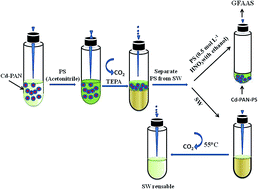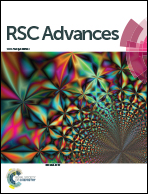Simple and green switchable dispersive liquid–liquid microextraction of cadmium in water and food samples
Abstract
A green, switchable water dispersive liquid–liquid microextraction (SWDLL-ME) method is introduced for the first time as a preconcentration/separation tool for measuring trace levels of cadmium (Cd) in real water and food samples. In the present study, a switchable aqueous solution of polar organic solvent (acetonitrile) was reversibly switched (on and off) from miscible monophasic to immiscible biphasic in aqueous medium by exposure to an anti-solvent trigger (CO2). The developed SWDLL-ME was successfully applied as an extraction method for the extraction of a Cd–PAN complex (1-(2-pyridylazo)-2-naphthol) in polar organic solvent (PS). The solvent enriched phase containing Cd–PAN was separated from the switchable water (SW) and treated with 200 μL of 0.1 mol L−1 HNO3 with ethanol (1 : 1, v/v) in order to reduce its viscosity, and it was then easily injected into a GFAAS for analysis. The SW was reused for the next assay after the removal of CO2. The switching phenomenon of the SW from low to high polarity was confirmed by FTIR spectroscopy and conductivity measurements. The enrichment factor and limit of detection of the proposed method were 22 and 0.38 ng L−1, respectively. Validation of the developed method was carried out by analyzing certified reference materials (SLRS-4 Riverine water and NIST SRM 1515 Apple leaves).



 Please wait while we load your content...
Please wait while we load your content...